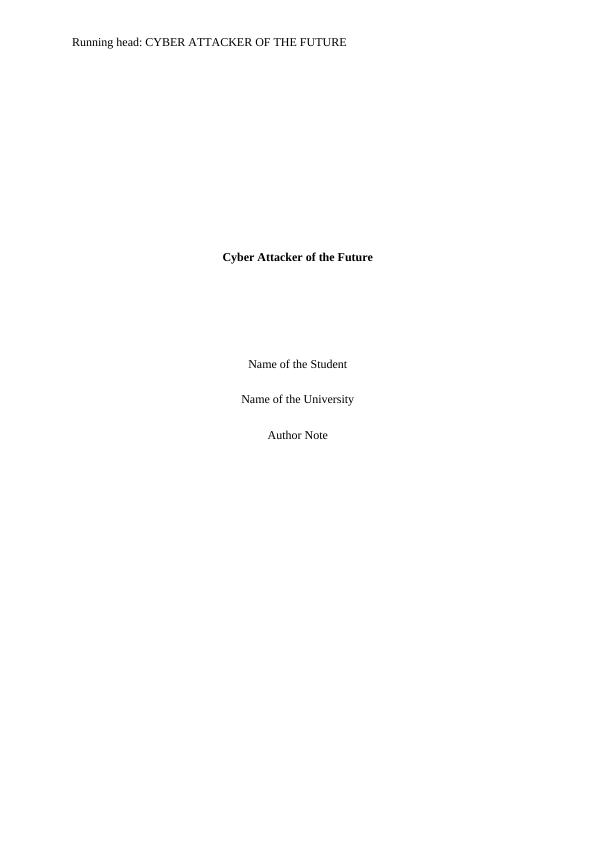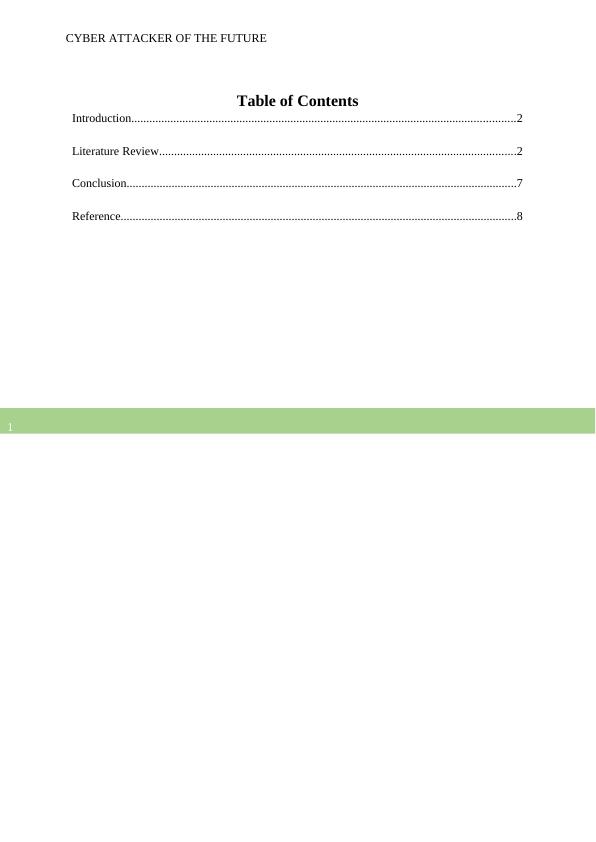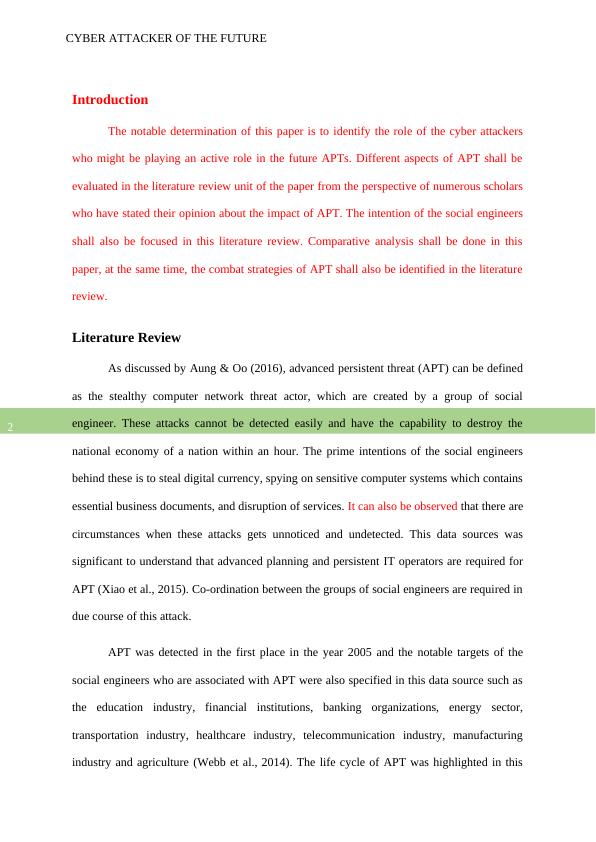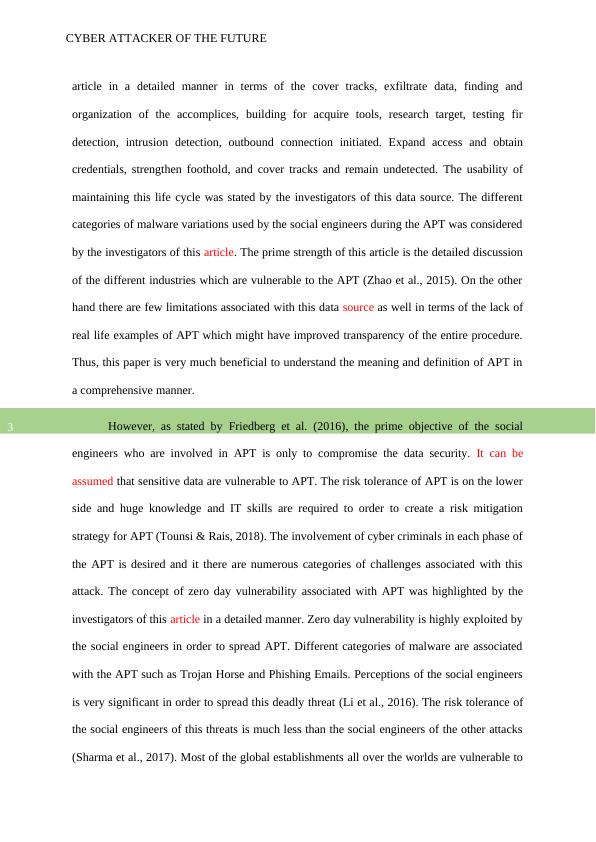Cyber Attacker of the Future
Added on 2022-12-18
12 Pages3220 Words39 Views
Running head: CYBER ATTACKER OF THE FUTURE
Cyber Attacker of the Future
Name of the Student
Name of the University
Author Note
Cyber Attacker of the Future
Name of the Student
Name of the University
Author Note

CYBER ATTACKER OF THE FUTURE
1
Table of Contents
Introduction................................................................................................................................2
Literature Review.......................................................................................................................2
Conclusion..................................................................................................................................7
Reference....................................................................................................................................8
1
Table of Contents
Introduction................................................................................................................................2
Literature Review.......................................................................................................................2
Conclusion..................................................................................................................................7
Reference....................................................................................................................................8

CYBER ATTACKER OF THE FUTURE
2
Introduction
The notable determination of this paper is to identify the role of the cyber attackers
who might be playing an active role in the future APTs. Different aspects of APT shall be
evaluated in the literature review unit of the paper from the perspective of numerous scholars
who have stated their opinion about the impact of APT. The intention of the social engineers
shall also be focused in this literature review. Comparative analysis shall be done in this
paper, at the same time, the combat strategies of APT shall also be identified in the literature
review.
Literature Review
As discussed by Aung & Oo (2016), advanced persistent threat (APT) can be defined
as the stealthy computer network threat actor, which are created by a group of social
engineer. These attacks cannot be detected easily and have the capability to destroy the
national economy of a nation within an hour. The prime intentions of the social engineers
behind these is to steal digital currency, spying on sensitive computer systems which contains
essential business documents, and disruption of services. It can also be observed that there are
circumstances when these attacks gets unnoticed and undetected. This data sources was
significant to understand that advanced planning and persistent IT operators are required for
APT (Xiao et al., 2015). Co-ordination between the groups of social engineers are required in
due course of this attack.
APT was detected in the first place in the year 2005 and the notable targets of the
social engineers who are associated with APT were also specified in this data source such as
the education industry, financial institutions, banking organizations, energy sector,
transportation industry, healthcare industry, telecommunication industry, manufacturing
industry and agriculture (Webb et al., 2014). The life cycle of APT was highlighted in this
2
Introduction
The notable determination of this paper is to identify the role of the cyber attackers
who might be playing an active role in the future APTs. Different aspects of APT shall be
evaluated in the literature review unit of the paper from the perspective of numerous scholars
who have stated their opinion about the impact of APT. The intention of the social engineers
shall also be focused in this literature review. Comparative analysis shall be done in this
paper, at the same time, the combat strategies of APT shall also be identified in the literature
review.
Literature Review
As discussed by Aung & Oo (2016), advanced persistent threat (APT) can be defined
as the stealthy computer network threat actor, which are created by a group of social
engineer. These attacks cannot be detected easily and have the capability to destroy the
national economy of a nation within an hour. The prime intentions of the social engineers
behind these is to steal digital currency, spying on sensitive computer systems which contains
essential business documents, and disruption of services. It can also be observed that there are
circumstances when these attacks gets unnoticed and undetected. This data sources was
significant to understand that advanced planning and persistent IT operators are required for
APT (Xiao et al., 2015). Co-ordination between the groups of social engineers are required in
due course of this attack.
APT was detected in the first place in the year 2005 and the notable targets of the
social engineers who are associated with APT were also specified in this data source such as
the education industry, financial institutions, banking organizations, energy sector,
transportation industry, healthcare industry, telecommunication industry, manufacturing
industry and agriculture (Webb et al., 2014). The life cycle of APT was highlighted in this

CYBER ATTACKER OF THE FUTURE
3
article in a detailed manner in terms of the cover tracks, exfiltrate data, finding and
organization of the accomplices, building for acquire tools, research target, testing fir
detection, intrusion detection, outbound connection initiated. Expand access and obtain
credentials, strengthen foothold, and cover tracks and remain undetected. The usability of
maintaining this life cycle was stated by the investigators of this data source. The different
categories of malware variations used by the social engineers during the APT was considered
by the investigators of this article. The prime strength of this article is the detailed discussion
of the different industries which are vulnerable to the APT (Zhao et al., 2015). On the other
hand there are few limitations associated with this data source as well in terms of the lack of
real life examples of APT which might have improved transparency of the entire procedure.
Thus, this paper is very much beneficial to understand the meaning and definition of APT in
a comprehensive manner.
However, as stated by Friedberg et al. (2016), the prime objective of the social
engineers who are involved in APT is only to compromise the data security. It can be
assumed that sensitive data are vulnerable to APT. The risk tolerance of APT is on the lower
side and huge knowledge and IT skills are required to order to create a risk mitigation
strategy for APT (Tounsi & Rais, 2018). The involvement of cyber criminals in each phase of
the APT is desired and it there are numerous categories of challenges associated with this
attack. The concept of zero day vulnerability associated with APT was highlighted by the
investigators of this article in a detailed manner. Zero day vulnerability is highly exploited by
the social engineers in order to spread APT. Different categories of malware are associated
with the APT such as Trojan Horse and Phishing Emails. Perceptions of the social engineers
is very significant in order to spread this deadly threat (Li et al., 2016). The risk tolerance of
the social engineers of this threats is much less than the social engineers of the other attacks
(Sharma et al., 2017). Most of the global establishments all over the worlds are vulnerable to
3
article in a detailed manner in terms of the cover tracks, exfiltrate data, finding and
organization of the accomplices, building for acquire tools, research target, testing fir
detection, intrusion detection, outbound connection initiated. Expand access and obtain
credentials, strengthen foothold, and cover tracks and remain undetected. The usability of
maintaining this life cycle was stated by the investigators of this data source. The different
categories of malware variations used by the social engineers during the APT was considered
by the investigators of this article. The prime strength of this article is the detailed discussion
of the different industries which are vulnerable to the APT (Zhao et al., 2015). On the other
hand there are few limitations associated with this data source as well in terms of the lack of
real life examples of APT which might have improved transparency of the entire procedure.
Thus, this paper is very much beneficial to understand the meaning and definition of APT in
a comprehensive manner.
However, as stated by Friedberg et al. (2016), the prime objective of the social
engineers who are involved in APT is only to compromise the data security. It can be
assumed that sensitive data are vulnerable to APT. The risk tolerance of APT is on the lower
side and huge knowledge and IT skills are required to order to create a risk mitigation
strategy for APT (Tounsi & Rais, 2018). The involvement of cyber criminals in each phase of
the APT is desired and it there are numerous categories of challenges associated with this
attack. The concept of zero day vulnerability associated with APT was highlighted by the
investigators of this article in a detailed manner. Zero day vulnerability is highly exploited by
the social engineers in order to spread APT. Different categories of malware are associated
with the APT such as Trojan Horse and Phishing Emails. Perceptions of the social engineers
is very significant in order to spread this deadly threat (Li et al., 2016). The risk tolerance of
the social engineers of this threats is much less than the social engineers of the other attacks
(Sharma et al., 2017). Most of the global establishments all over the worlds are vulnerable to

End of preview
Want to access all the pages? Upload your documents or become a member.
Related Documents
Privacy Concerns in Social Networkinglg...
|15
|794
|78
Social Engineering Phishing Attacks Paperlg...
|5
|2170
|343
Use of Machine Learning to Improve the Internet of Things Based Applications | PPTlg...
|1
|1527
|9
Why phishing still works: User strategies for combating phishing attackslg...
|3
|2242
|112
Human Behaviour in Cybersecurity: Impact on Data Securitylg...
|68
|13665
|232
Change Management in Healthcare - Assignmentlg...
|12
|3069
|98
